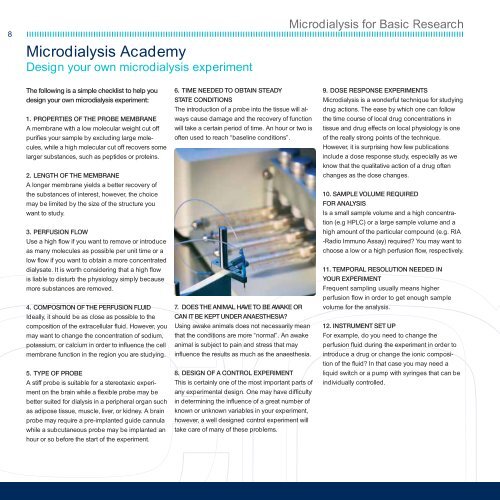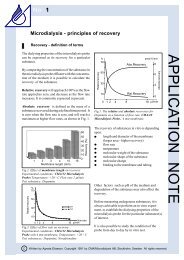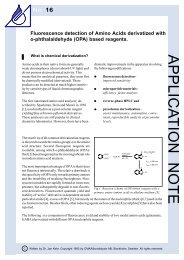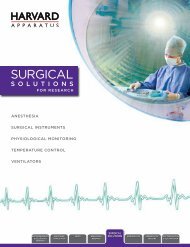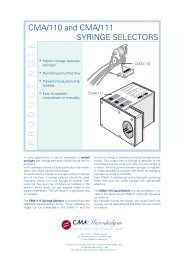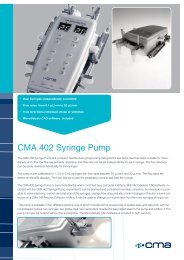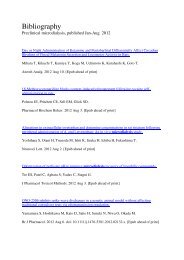MICRODIALYSIS - CMA Microdialysis AB
MICRODIALYSIS - CMA Microdialysis AB
MICRODIALYSIS - CMA Microdialysis AB
Create successful ePaper yourself
Turn your PDF publications into a flip-book with our unique Google optimized e-Paper software.
8<br />
<strong>Microdialysis</strong> Academy<br />
Design your own microdialysis experiment<br />
<strong>Microdialysis</strong> for Basic Research<br />
The following is a simple checklist to help you<br />
design your own microdialysis experiment:<br />
1. PROPERTIES OF THE PROBE MEMBRANE<br />
A membrane with a low molecular weight cut off<br />
purifies your sample by excluding large molecules,<br />
while a high molecular cut off recovers some<br />
larger substances, such as peptides or proteins.<br />
2. LENGTH OF THE MEMBRANE<br />
A longer membrane yields a better recovery of<br />
the substances of interest, however, the choice<br />
may be limited by the size of the structure you<br />
want to study.<br />
3. PERFUSION FLOW<br />
Use a high flow if you want to remove or introduce<br />
as many molecules as possible per unit time or a<br />
low flow if you want to obtain a more concentrated<br />
dialysate. It is worth considering that a high flow<br />
is liable to disturb the physiology simply because<br />
more substances are removed.<br />
4. COMPOSITION OF THE PERFUSION FLUID<br />
Ideally, it should be as close as possible to the<br />
composition of the extracellular fluid. However, you<br />
may want to change the concentration of sodium,<br />
potassium, or calcium in order to influence the cell<br />
membrane function in the region you are studying.<br />
5. TYPE OF PROBE<br />
A stiff probe is suitable for a stereotaxic experiment<br />
on the brain while a flexible probe may be<br />
better suited for dialysis in a peripheral organ such<br />
as adipose tissue, muscle, liver, or kidney. A brain<br />
probe may require a pre-implanted guide cannula<br />
while a subcutaneous probe may be implanted an<br />
hour or so before the start of the experiment.<br />
6. TIME NEEDED TO OBTAIN STEADY<br />
STATE CONDITIONS<br />
The introduction of a probe into the tissue will always<br />
cause damage and the recovery of function<br />
will take a certain period of time. An hour or two is<br />
often used to reach “baseline conditions”.<br />
7. DOES THE ANIMAL HAVE TO BE AWAKE OR<br />
CAN IT BE KEPT UNDER ANAESTHESIA<br />
Using awake animals does not necessarily mean<br />
that the conditions are more “normal”. An awake<br />
animal is subject to pain and stress that may<br />
influence the results as much as the anaesthesia.<br />
8. DESIGN OF A CONTROL EXPERIMENT<br />
This is certainly one of the most important parts of<br />
any experimental design. One may have difficulty<br />
in determining the influence of a great number of<br />
known or unknown variables in your experiment,<br />
however, a well designed control experiment will<br />
take care of many of these problems.<br />
9. DOSE RESPONSE EXPERIMENTS<br />
<strong>Microdialysis</strong> is a wonderful technique for studying<br />
drug actions. The ease by which one can follow<br />
the time course of local drug concentrations in<br />
tissue and drug effects on local physiology is one<br />
of the really strong points of the technique.<br />
However, it is surprising how few publications<br />
include a dose response study, especially as we<br />
know that the qualitative action of a drug often<br />
changes as the dose changes.<br />
10. SAMPLE VOLUME REQUIRED<br />
FOR ANALYSIS<br />
Is a small sample volume and a high concentration<br />
(e.g HPLC) or a large sample volume and a<br />
high amount of the particular compound (e.g. RIA<br />
-Radio Immuno Assay) required You may want to<br />
choose a low or a high perfusion flow, respectively.<br />
11. TEMPORAL RESOLUTION NEEDED IN<br />
YOUR EXPERIMENT<br />
Frequent sampling usually means higher<br />
perfusion flow in order to get enough sample<br />
volume for the analysis.<br />
12. INSTRUMENT SET UP<br />
For example, do you need to change the<br />
perfusion fluid during the experiment in order to<br />
introduce a drug or change the ionic composition<br />
of the fluid In that case you may need a<br />
liquid switch or a pump with syringes that can be<br />
individually controlled.


